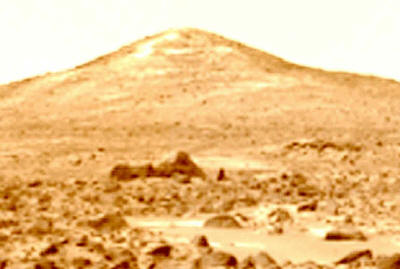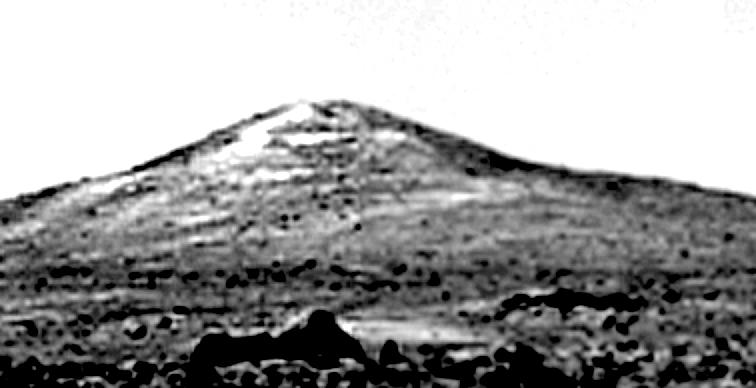In Search of The Martian Sphinx
By
Mike Bara

The "Pathfinder Sphinx" in front of the North "Twin Peak"
Awhile back, I wrote a piece for the Enterprise Mission in which I showed images produced by NASA's Super Resolution Surface Modeling technique which had shed greater light on a distant object in the debris field around the Mars Pathfinder landing site. I equated the object and some surrounding geometric features to the Great Sphinx at Giza, a conclusion for which I naturally was lambasted by our steady supply of harsh critics, one even going so far as to call my conclusions "delusional."
In reading over these attacks in the last few months, I was struck by just how difficult it was for the critics to get their brains around what are clear and obvious characteristics of the objects in question. My working assumption is that most of our critics don't see what we see because they choose not to, because they really don't want to confront the next set of questions that are inevitably raised by the mere presence of something so scary as a "sphinx" at the Pathfinder landing site.
But the truth is we are fighting an even more difficult uphill battle than that. We are battling the limits of human perception.
When one of these critics took out after my assertion that "Sphinx" was facing East, by trying to claim that the "Sphinx" and "temples" were the same object, I realized this might indeed be what the problem was. Most of us are aware that certain people are color blind, they cannot distinguish between certain sets of colors. The same principal applies with 3-D projection from 2-D datasets.
A large chunk of the population is able to do spatial projection in their heads -- in other words, they can look at a 2-D image and quickly visualize the shape of the object in three-dimensions. This is a natural gift, something that about a third of the population is born with. Roughly another third of the population possesses some ability to process information in this manner, and can be trained to develop the skills and ability to do 3-D projection in their heads. In some cases they will never get "good" at it, they will always take more time to "get" something than someone who is naturally gifted in this manner.
Another third of the population does not have this innate ability at all. They can stare at a picture for hours, and never see what you are pointing out to them. That's why you can show an image of Mars to your wife and she will have no idea what you are pointing at. She's not being difficult, she simply can't see what you see. Virtually all the worlds engineers and draftsman come from the first two groups, for obvious reasons, and the majority of individuals who can project easily in 3-D are men. That's another reason most engineers are male.

In looking at the geometric patterning on the South Twin Peak, I can easily see the layered, step-like structure, whereas somebody who does not have my ability or experience (I've spent my entire adult working life, 23 years, in engineering doing exactly this) simply doesn't visualize it. But it is undeniably there.

Likewise, the critics seem unable to recognize the bizarre geometric shapes that make up the "Sphinx." To my eye, the "Sphinx" and "Temples" are made up of a series of obvious geometric forms that simply do not belong in a naturally formed "debris field." The Sphinx has a triangular body, rectangular "forepaws", a square "face" and a symmetrical "nemes" style headdress. Behind the "Sphinx" is a flat, vertical wall, with a wedge shaped protrusion and a hexagonal protrusion to the left. I can easily see the depth here, but the reality is that somebody who does have not good spatial perception skills would not "get" this critical third dimension.

Let me illustrate my point. Above is rough approximation of the objects as I see them at the Pathfinder site, reconstructed with a solid object modeling CAD program (this not an exact reproduction, merely a quick and dirty job to illustrate my point). When rotated to approximately the same perspective as the Pathfinder camera image, the objects seem to blend together, giving the illusion (to the untrained eye) that it is all part of the same object, as my critic concludes.

But with solid modeling software, we have the luxury of being able to rotate the viewing perspective. In this way we can see that the notion that the objects are all joined is not necessarily true. Because of the viewing perspective, objects which are actually widely separated on the ground can appear to be one and the same to Pathfinder's camera lens.
This is exactly the critics problem. Their inability to see the various possibilities and do some rotation "in their heads" leads them to make spurious assumptions -- for instance, that the "Sphinx and Temples" are the same object.
Other criticisms have included the charge that my arguments are contradictory. Critics point out that it is unlikely that a "sphinx" could survive intact in an area devastated by large flood. This is simply not a logical conclusion. Ron Nicks, in his geologic analysis of the Pathfinder site, concluded that there was indeed a brief but violent (is there any other kind?) flood in the area sometime in the past. He asserted that the front casing wall of the south peak pyramid had been torn off in this process.
So how could the "sphinx" have survived (relatively) intact? Easy. The water flowed around it.

Water, like any other liquid flow, will take the path of least resistance. In these images of "islands" on Mars from the Viking missions, you can see how water flowed around features rather than over them. The same logic applies to the Pathfinder landing site. In fact, if the water flow came from behind the pyramids, essentially right at the camera from Pathfinder's perspective, as Nicks projects, then objects in the near foreground would have been protected by the presence of the peak itself, which is why it sustained the brunt of the damage (by having it's front casing ripped off). So it is not contradictory in any way to assume that a possible artificial structure survived intact.
In the end, what separates the "Pathfinder Sphinx" from most other objects imaged from the surface of Mars is its geometric shape, distinctive features and symbolic placement. As I have demonstrated, the true shape and location of an object in 3-D can be very different from the illusion created by the 2-D image, especially if the viewer is inexperienced or "spatially challenged." Regardless of whether the "Sphinx" is one object or two, it clearly has distinctive block-like features that are not produced commonly in naturally occurring rocks, especially rocks that sit at the base of layered, structured pyramids ...
... that just happen to be at 19.5° by 33° on the surface of Mars.
Man, would I love to see the "real" pictures of this thing that JPL must have ...
... MB
PS - We have it on good word that we will be hearing quite a bit more in the news about "Sphinx's" very soon. But not on Mars ...
... off the coast of Cuba. Stay Tuned.